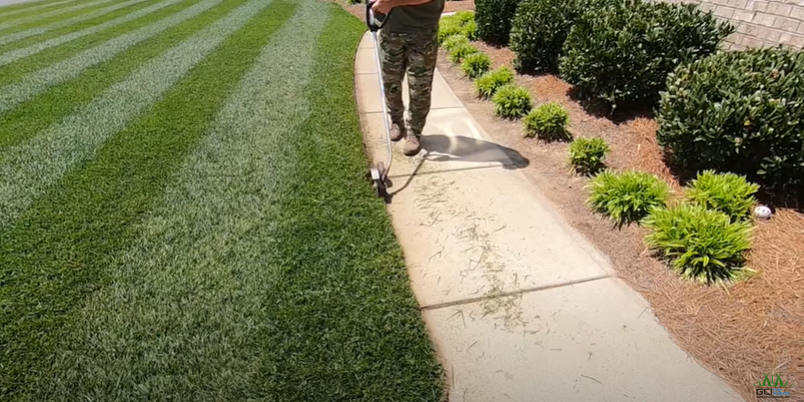Edging Your Lawn: Creating a Defined Boundary for a Neat and Tidy Look
Maintaining a well-manicured lawn can make a significant difference in the overall appearance of your property. One essential aspect of lawn care is edging, which involves creating a defined boundary between your lawn and other features, such as driveways, walkways, or flower beds. This process may seem like a small detail, but it can have a considerable impact on the overall look of your lawn.
Benefits of Edging Your Lawn
1. Adds definition to your lawn
One of the primary benefits of edging your lawn is that it adds definition to your lawn. By creating a clear boundary between your lawn and other features, such as driveways or walkways, you create a visual distinction that adds to the overall look of your lawn. This definition can make your lawn appear more organized and well-kept.
2. Prevents grass from spreading
Another advantage of edging your lawn is that it prevents grass from spreading into unwanted areas. Grass has a natural tendency to grow in all directions, including into flower beds and walkways. By creating a clear boundary between your lawn and these areas, you can prevent grass from spreading and keep these areas neat and tidy.
3. Improves curb appeal
Curb appeal is essential when it comes to the overall value of your property. A well-maintained lawn can make a significant difference in how your property is perceived by potential buyers or renters. Edging your lawn is an easy and effective way to improve your property’s curb appeal and make it more attractive to potential buyers or renters.
Tips for Edging Your Lawn
1. Choose the right tools
The first step to edging your lawn is to choose the right tools. There are several tools available for edging, including manual edgers, electric edgers, and gas-powered edgers. Each type of edger has its advantages and disadvantages, so it’s important to choose the one that’s best suited for your needs.
Manual edgers are the most affordable option but require more physical effort to use. Electric edgers are more expensive but are easier to use and require less physical effort. Gas-powered edgers are the most powerful but are also the most expensive and require regular maintenance.
2. Mark the boundary
Before you start edging, it’s essential to mark the boundary between your lawn and other features. This will help ensure that your edging line is straight and even. You can use stakes and string or a can of spray paint to mark the boundary.
3. Cut a clean edge
When edging your lawn, it’s important to cut a clean edge. This means using your edger to create a straight, even line along the boundary. Take your time and make sure the line is as straight as possible. A crooked or uneven edge can detract from the overall look of your lawn.
4. Remove debris
Once you’ve finished edging, it’s important to remove any debris from the boundary. This includes grass clippings, dirt, and other debris that may have accumulated during the edging process. Removing debris will help ensure that your edging line looks neat and tidy.
5. Maintain your edging line
Finally, it’s important to maintain your edging line. This means regularly checking the boundary to ensure that it remains straight and even. Over time, the boundary may shift or become uneven, so it’s important to make any necessary adjustments to keep it looking neat and tidy.
Edging your lawn is an essential aspect of lawn care that can make a significant difference in the overall appearance of your property. By adding definition to your lawn, preventing grass from spreading, and improving curb appeal, edging is an effective way to maintain a neat and tidy lawn. To get the best results, it’s important to choose the right tools, mark the boundary, cut a clean edge, remove debris, and maintain your edging line.
In addition to these tips, there are a few other things you can do to make your edging even more effective. For example, you can use a weed eater to trim any grass that may be growing along the edging line. This will help keep the line looking neat and tidy and prevent grass from spreading into unwanted areas.
Another tip is to edge your lawn regularly. Depending on how fast your grass grows, you may need to edge your lawn every few weeks or so. Regular edging will help prevent grass from spreading into unwanted areas and keep your lawn looking neat and tidy all season long.
Finally, it’s important to remember that edging your lawn is just one aspect of lawn care. To maintain a healthy and vibrant lawn, you’ll also need to mow, water, fertilize, and aerate your lawn on a regular basis. By taking care of your lawn and edging it regularly, you can create a beautiful and inviting outdoor space that you can enjoy all year long.
Edging your lawn is an essential part of lawn care that can have a significant impact on the overall look of your property. By adding definition to your lawn, preventing grass from spreading, and improving curb appeal, edging is an effective way to maintain a neat and tidy lawn. To get the best results, it’s important to choose the right tools, mark the boundary, cut a clean edge, remove debris, and maintain your edging line. With these tips and a little bit of effort, you can create a beautiful and inviting outdoor space that you can enjoy for years to come.

